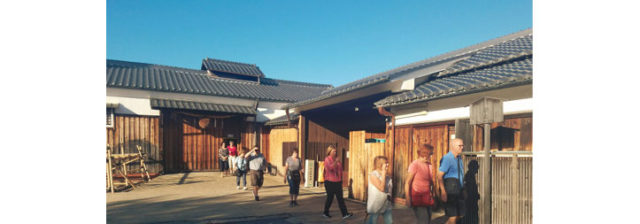During our four-day stay in Kyoto, the 2019 fall tour members visited the Fushimi area, south of the Kyoto city center. Fushimi is known as “Sake-Dokoro” meaning a place for sake production since the early 16th century. The town is surrounded by waterways that were used to ship sake barrels from Fushimi to Kyoto and downtown Osaka. We enjoyed walking along the waterway, stopping at historic spots such as Teradaya — a historic inn where a hero of the Meiji Restoration Ryoma Sakamoto used to reside.

Our main destination in Fushimi was Gekkeikan Okura Sake Museum. Operated by Gekkeikan Sake Company, the museum is housed in its old sake brewery that was built in 1909. As we got closer to the building, we noticed a nice sake aroma.

Gekkeikan’s history goes back to 1637 when its predecessor Kasagiya was founded by Jiemon Okura (1615-1684). The existing facility was built by Tsunekichi Okura (1874-1950), the 11th generation head of Kasagiya and the founder of Gekkeikan Sake Company. Tsunekichi established his R&D lab inside the building and started bottling sake without preservatives. It was the time when barreled sake was still mainstream. The bottling technology soon resulted in Gekkeikan’s leap from Kyoto’s local sake into a national brand as railway transportation expanded in Japan. Gekkeikan’s sake production increased from 90,000 liters to 9 million liters under Tsunekichi’s leadership. Sake bottling was an important breakthrough for the history of sake as it allowed high-quality sake to be available at a reasonable price for the increasing middle-class workers during the age of Japan’s modernization. Even after the rapid Westernization of Japan, sake remained on the table of Japanese families.
In the museum, traditional tools and equipment that were used by the brewer in the early 20th century are displayed. Many of them are registered by the City of Kyoto as Tangible Cultural Assets. The exhibit details the history of sake and the brewer from the Edo period to its modernizing days in the Meiji and Taisho eras. The most interesting part for me was the collection of old labels and posters. It was fascinating to find how Tsunekichi and his team adopted modern branding and advertisements while modernizing production.

Our group listened to a lecture about sake brewing inside the “Sakekobo (brewery),” where Gekkeikan still produces some of its products. We learned about layers of the fermentation processes to make pure rice and water into sake. We were able to see and smell different stages of fermentation. It was amazing how the fruity aroma was made only from rice and water but nothing else. The highly controlled fermentation processes allow commercial sake bottling without using any preservatives. At the end of the lecture, we tasted some of the sake products from the brewer.

Before I left the museum, I bought a bottle of “nama sake” (raw unpasteurized sake), which is brewed in the museum’s brewery and only available at the museum’s gift store. It was one of the best sakes I have ever tasted. Our next Spring Tour will go back to the sake museum again.
Gekkeikan Okura Sake Museum
more info: www.gekkeikan.co.jp/english/kyotofushimi/museum.html247 Minamihama-cho, Fushimi-ku, Kyoto City 612-8660, Japan




